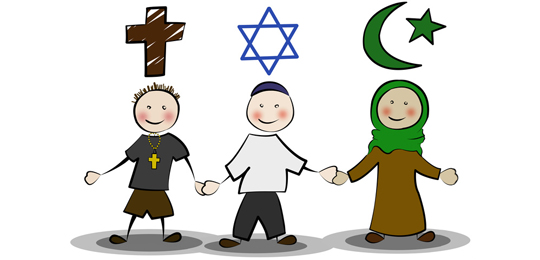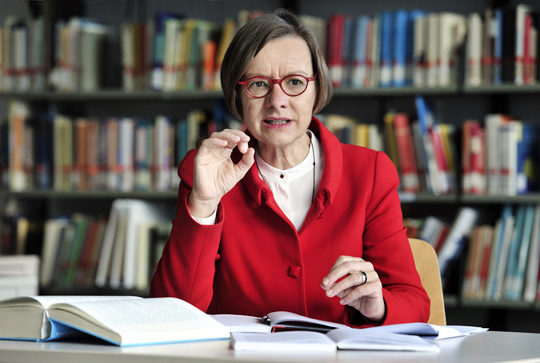Religious Diversity in School
Freiburg, May 04, 2018
Anti-Semitic incidents in school, attacks on men wearing the kippah in public: recently religion has become a topic of conflict, increasingly accompanied by aggressive assaults. Schools must respond and counter racism, say many – but what form should a lesson take if it is to create understanding for other religions? Eva Opitz asked Freiburg religious teaching expert Prof. Dr. Mirjam Schambeck what an interreligious education might look like and whether it can have a positive effect on coexistence in a society with different faiths.
 Photo: Rose Winter/Fotolia
Photo: Rose Winter/Fotolia
Ms. Schambeck, do you have an explanation for why religiously motivated conflicts are increasingly accompanied by violence?
Mirjam Schambeck: I’d like to go back a bit further here, if I might. Since the Enlightenment and the associated division of state and religion, religion has largely become a private matter. To begin with this was positive, because it contributed to the establishment of a peaceful society. Religion became a kind of matter of personal taste. However, with the privatization of religion, we have lost the theological vocabulary. Knowledge of our own religion has declined and we also know too little about those of others.
So why is this important now?
We are living in a society in which religion has once again become a public matter. A reasonable encounter with other religions is increasingly necessary in view of aggressive assaults. We need educated religious experts as well as places where interreligious education is given. Above all that means schools and universities. Religious lessons in general are predestined as a place for this.
What does the term “interreligious” mean in this context?
An interreligious education can be described as people’s ability to come to terms with a plurality of religions, that is the diversity of religions. For instance, there can’t be an understanding of Christianity without Judaism, and in Germany not without Islam either. There are many examples of how other religions have influenced Christianity: we have Islam to thank for bell-ringing, for example. St. Francis of Assisi was so fascinated by the Muslims’ call to prayer five times a day that he sought a melodious imitation.
How can schools convey interreligious skills?
Religious lessons have become the first place of religious education for many children and teenagers. They are enabled to form their own sound position. Religious lessons shouldn’t be a way of recruiting believers, they should guide school pupils in how to reflect critically on issues. The goals of teaching are the ability to think and judge. Anyone who wants to respond must know something. Religion is a system of discourse and at the same time a conviction, that is, a way of bringing validity into one’s life. It is important to illustrate this dual structure. So, university-educated teachers should have a religious conviction.
 “Religious lessons shouldn’t be a way of recruiting believers, they should guide school pupils in how to reflect critically on issues,” says Mirjam Schambeck.
“Religious lessons shouldn’t be a way of recruiting believers, they should guide school pupils in how to reflect critically on issues,” says Mirjam Schambeck.
Photo: Thomas Kunz
What form would these lessons take in real terms?
The ideal would be a pluralistic religious lesson oriented by confessions, in the familiar class group. It might for instance take the form that in the first phase theological questions are raised, such as the question of the meaning of life. These are first of all looked at with the school pupils by teachers with a religious confession, that is, by Christian, Jewish or Islamic. In the second, dialogical phase, the study groups come together to present to each other what the Christian, Jewish and Muslim perspectives are on each lesson topic. In the third study phase, they then reflect on the meaning of what they have learned for their own position.
What qualities should teachers have in order to be sensitive to migration in lessons?
They have to know precisely where they can start and inquire, what knowledge is already present. However, the important thing is to develop their own knowledge about cultural backgrounds. For example, teachers must never ask which school pupils are Sunni and which are Shiite. This forces the youngsters to “come out” and may expose them to conflict.
How good do you think the chance is that interreligious education could limit religiously motivated conflicts?
If I didn’t believe at all that reason could defuse conflicts, I’d have to give up. At the same time, I’m not simply optimistic. It’s also because such disputes have been shown to have their roots in social conflicts. It’s a call to participation, expressed in religious semantics. Religion becomes a vehicle for protesting against exclusion and lack of respect.
How should society act?
When kippah wearers are attacked – as happened in Berlin – we mustn’t withdraw, we have to show vocal solidarity with our Jewish fellow citizens. If some people start again to degrade and demean others, and think they can decide who belongs and who doesn’t, that’s the old Nazi model. It’s enjoying a revival at the moment, including in the AfD.
Can politics also contribute to exclusion, even using religious symbols and semantics?
The most recent example of this is the campaign by the CSU Minister-President of Bavaria Markus Söder. He wants to have crucifixes hung in all Bavarian government offices, indicating that it is part of Bavarian identity. In this way he utterly ignores the fact that the crucifix is simply the religious symbol of Christianity and cannot be restricted to one cultural identity. It is not appropriate as a sign of exclusion. Quite the contrary! The crucifix includes, it doesn’t exclude. It doesn’t belong to a single group, nation, ethnic or gender group. Not to the Bavarians either. It belongs to all of us.

